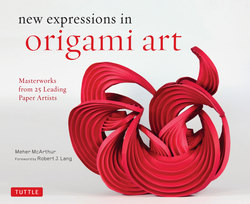Читать книгу New Expressions in Origami Art - Meher McArthur - Страница 10
На сайте Литреса книга снята с продажи.
ОглавлениеINTRODUCTION
Dwarf
Eric Joisel, France 2003, paper (Photo courtesy of the artist’s family)
Origami—the Japanese art of paper folding—has become so popular that it is now being practiced all around the world, and not only by children but by many highly innovative artists. Since the 1950s, when Japanese origami artist Akira Yoshizawa began using wet folding to model original, realistic forms, artists all over the world have been inspired to push the boundaries of paper folding. Some began their artistic journey with traditional origami and have found ways to fold increasingly complex and sculptural forms, while others were sculptors who discovered that folding paper presented them with a whole new world of possibilities. The result has been the emergence of a unique type of sculptural art that begins in two dimensions and ends in three.
By experimenting with new techniques such as wet folding, curved creasing and tessellations, and using a wide variety of papers, artists from all over the world have been following their own aesthetic, poetic and political inclinations, elevating paper folding into a sophisticated global art form that now comprises many different styles and genres. Although folded birds, insects and animals remain a key element in this evolution, origami art now includes works of abstract sculpture, large-scale installations, street art and conceptual works that express contemporary social, political and aesthetic ideas. Origami has become a multifaceted method of artistic expression.
The origami artists featured here are some of the most innovative working today (save for Eric Joisel, recently deceased, but whose spirit is still felt strongly). They have been vigorously pushing the boundaries of origami in new directions in terms of style, scale, materials, subject and concept. Fueled by their boundless imagination and formed with remarkable skill, their origami creations are increasing in size, with larger single sheets or multiple modules being assembled into large-scale sculptures that blend geometry and grace. They are creasing and crumpling paper to create fantastic new worlds inhabited by lifelike organisms. They are folding sheets of paper along curved lines so that they twist and swirl in unexpected directions. They are combining their folded paper creations with other media, even encasing them inside vessels of glass. They are folding paper as a way of expressing their concerns about religious, social and political issues. Now, we are not only awed by the intricacy of their folding and the beauty of their folded forms, but we are also moved by the power of the message contained in the work.
The artists featured in this book are from eleven different countries on four continents. Many of them know, and have been inspired by each other. Some have been active in the origami community for years, while others have only recently discovered the community of other paper folders out there. Some are inspired solely by aesthetics, while others use their art to make a political or social point. What they share is a place in an important moment in the history of origami, when what was once considered Japanese has become truly global and what was once only seen as a craft is being recognized as an art form—and one with infinite modes of expression.
MEHER MCARTHUR
independent Asian art curator, educator and co-author of Folding Paper: The Infinite Possibilities of Origami
